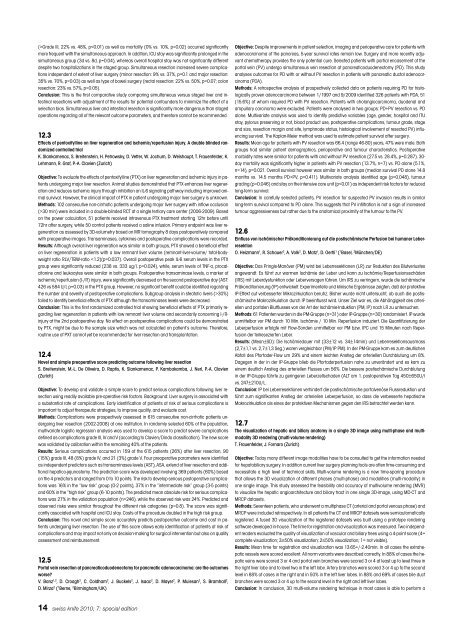Anorectal Manometry in 3D NEW! - Swiss-knife.org
Anorectal Manometry in 3D NEW! - Swiss-knife.org
Anorectal Manometry in 3D NEW! - Swiss-knife.org
Create successful ePaper yourself
Turn your PDF publications into a flip-book with our unique Google optimized e-Paper software.
(>Grade III, 22% vs. 48%, p30 m<strong>in</strong>) were <strong>in</strong>cluded <strong>in</strong> a double-bl<strong>in</strong>ded RCT at a s<strong>in</strong>gle tertiary care center (2006-2009). Based<br />
on the power calculation, 51 patients received <strong>in</strong>travenous PTX treatment start<strong>in</strong>g 12hr before until<br />
72hr after surgery, while 50 control patients received a sal<strong>in</strong>e <strong>in</strong>fusion. Primary endpo<strong>in</strong>t was liver regeneration<br />
as assessed by <strong>3D</strong>-volumetry based on MR tomography 8 days postoperatively compared<br />
with preoperative images. Transam<strong>in</strong>ases, cytok<strong>in</strong>es and postoperative complications were recorded.<br />
Results: Although overall liver regeneration was similar <strong>in</strong> both groups, PTX showed a beneficial effect<br />
on liver regeneration <strong>in</strong> patients with a low remnant liver volume (remnant-liver-volume/ total-bodyweight<br />
ratio RLV/TBW-ratio 30%)<br />
failed to identify beneficial effects of PTX although the transam<strong>in</strong>ases levels were decreased.<br />
Conclusion: This is the first randomized controlled trial show<strong>in</strong>g beneficial effects of PTX primarily regard<strong>in</strong>g<br />
liver regeneration <strong>in</strong> patients with low remnant liver volume and secondarily concern<strong>in</strong>g I-/R<strong>in</strong>jury<br />
at the 2nd postoperative day. No effect on postoperative complications could be demonstrated<br />
by PTX, might be due to the sample size which was not calculated on patient’s outcome. Therefore,<br />
rout<strong>in</strong>e use of PXT cannot yet be recommended for liver resection and transplantation.<br />
12.4<br />
Novel and simple preoperative score predict<strong>in</strong>g outcome follow<strong>in</strong>g liver resection<br />
S. Breitenste<strong>in</strong>, M.-L. De Oliveira, D. Raptis, K. Slankamenac, P. Kambakamba, J. Nerl, P.-A. Clavien<br />
(Zurich)<br />
Objective: To develop and validate a simple score to predict serious complications follow<strong>in</strong>g liver resection<br />
us<strong>in</strong>g readily available pre-operative risk factors. Background: Liver surgery is associated with<br />
a substantial rate of complications. Early identification of patients at risk of serious complications is<br />
important to adjust therapeutic strategies, to improve quality, and evaluate cost.<br />
Methods: Complications were prospectively assessed <strong>in</strong> 615 consecutive non-cirrhotic patients undergo<strong>in</strong>g<br />
liver resection (2002-2008) at one <strong>in</strong>stitution. In randomly selected 60% of the population,<br />
multivariate logistic regression analysis was used to develop a score to predict severe complications<br />
def<strong>in</strong>ed as complications grade III, IV and V (accord<strong>in</strong>g to Clavien/D<strong>in</strong>do classification). The new score<br />
was validated by calibration with<strong>in</strong> the rema<strong>in</strong><strong>in</strong>g 40% of the patients.<br />
Results: Serious complications occurred <strong>in</strong> 159 of the 615 patients (26%) after liver resection, 90<br />
(15%) grade III, 48 (8%) grade lV, and 21 (3%) grade V. Four preoperative parameters were identified<br />
as <strong>in</strong>dependent predictors such as transam<strong>in</strong>ases levels (AST), ASA, extend of liver resection and additional<br />
hepatico-jejunostomy. The prediction score was developed <strong>in</strong>volv<strong>in</strong>g 369 patients (60%) based<br />
on the 4 predictors and ranged from 0 to 10 po<strong>in</strong>ts. The risk to develop serious postoperative complications<br />
was 16% <strong>in</strong> the “low risk” group (0-2 po<strong>in</strong>ts), 37% <strong>in</strong> the “<strong>in</strong>termediate risk” group (3-5 po<strong>in</strong>ts)<br />
and 60% <strong>in</strong> the “high risk” group (6-10 po<strong>in</strong>ts). The predicted mean absolute risk for serious complications<br />
was 27% <strong>in</strong> the validation population (n=246), while the observed risk was 24%. Predicted and<br />
observed risks were similar throughout the different risk categories (p=0.8). The score was significantly<br />
associated with hospital and ICU stay. Costs of the procedure doubled <strong>in</strong> the high risk group.<br />
Conclusion: This novel and simple score accurately predicts postoperative outcome and cost <strong>in</strong> patients<br />
undergo<strong>in</strong>g liver resection. The use of this score allows early identification of patients at risk of<br />
complications and may impact not only on decision-mak<strong>in</strong>g for surgical <strong>in</strong>tervention but also on quality<br />
assessment and reimbursement.<br />
12.5<br />
Portal ve<strong>in</strong> resection at pancreaticoduodenectomy for pancreatic adenocarc<strong>in</strong>oma: are the outcomes<br />
worse?<br />
V. Banz 1,2 , D. Croagh 2 , C. Coldham 2 , J. Buckels 2 , J. Isaac 2 , D. Mayer 2 , P. Muiesan 2 , S. Bramhall 2 ,<br />
D. Mirza 2 ( 1 Berne, 2 Birm<strong>in</strong>gham/UK)<br />
14 swiss <strong>knife</strong> 2010; 7: special edition<br />
Objective: Despite improvements <strong>in</strong> patient selection, imag<strong>in</strong>g and perioperative care for patients with<br />
adenocarc<strong>in</strong>oma of the pancreas, 5-year survival rates rema<strong>in</strong> low. Surgery and more recently adjuvant<br />
chemotherapy provides the only potential cure. Selected patients with partial encasement of the<br />
portal ve<strong>in</strong> (PV) undergo simultaneous ve<strong>in</strong> resection at pancreaticoduodenectomy (PD). This study<br />
analyses outcomes for PD with or without PV resection <strong>in</strong> patients with pancreatic ductal adenocarc<strong>in</strong>oma<br />
(PDA).<br />
Methods: A retrospective analysis of prospectively collected data on patients requir<strong>in</strong>g PD for histologically<br />
proven adenocarc<strong>in</strong>oma between 1/1997 and 9/2009 identified 326 patients with PDA, 51<br />
(15.6%) of whom required PD with PV resection. Patients with cholangiocarc<strong>in</strong>oma, duodenal and<br />
ampullary carc<strong>in</strong>oma were excluded. Patients were analysed <strong>in</strong> two groups: PD+PV resection vs. PD<br />
alone. Multivariate analysis was used to identify predictive variables (age, gender, hospital and ITU<br />
stay, pylorus preserv<strong>in</strong>g or not, blood product use, postoperative complications, tumour grade, stage<br />
and size, resection marg<strong>in</strong> and site, lymphnode status, histological <strong>in</strong>volvement of resected PV) <strong>in</strong>fluenc<strong>in</strong>g<br />
survival. The Kaplan-Meier method was used to estimate patient survival after surgery.<br />
Results: Mean age for patients with PV resection was 66.4 (range 46-80) years, 47% were male. Both<br />
groups had similar patient demographics, perioperative and tumour characteristics. Postoperative<br />
morbidity rates were similar for patients with and without PV resection (27.5 vs. 28.4%, p=0.287). 30day<br />
mortality was significantly higher <strong>in</strong> patients with PV resection (13.7%, n=7) vs. PD alone (5.1%,<br />
n=14), p=0.021. Overall survival however was similar <strong>in</strong> both groups (median survival PD alone 14.8<br />
months vs. 14.5 months PD+PV, p=0.411). Multivariate analysis identified age (p=0.048), tumour<br />
grad<strong>in</strong>g (p=0.046) and stay on the <strong>in</strong>tensive care unit (p
















